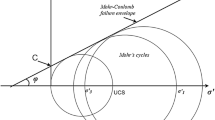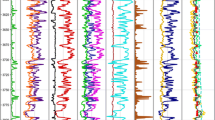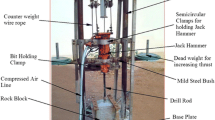Abstract
In this paper, an attempt has been made to predict the rate of penetration (ROP) of rocks by incorporating thrust, revolutions per minute (rpm), flushing media and compressive strength of rocks using artificial neural network (ANN) technique. A three-layer feed-forward back-propagation neural network with 4-7-1 architecture was trained using 472 experimental data sets of sandstone, limestone, rock phosphate, dolomite, marble and quartz-chlorite-schist rocks. A total of 146 new data sets were used for the testing and comparison of the ROP by ANN. Multivariate regression analysis (MVRA) has also been done with same data sets of ANN. ANN and MVRA results were compared based on coefficient of determination (CoD) and mean absolute error (MAE) between experimental and predicted values of ROP. The coefficient of determination by ANN was 0.985, while coefficient of determination was 0.629 for rate of penetration. The mean absolute error (MAE) for rate of penetration by ANN was 0.3547, whereas MAE by MVRA was 1.7499.








Similar content being viewed by others
References
Baheer I (2000) Selection of methodology for modeling hysteresis behavior of soils using neural networks. J Comput Aided Civil Infrastruct Eng 5(6):445–463
Basheer IA, Hajmeer M (2000) Artificial neural networks: fundamentals, computing, design, and application. J Microbiol Meth 43:3–31
Bhatnagar A, Khandelwal M, Rao KUM (2010) Performance enhancement by addition of non-ionic polymer in flushing media for diamond drilling in rock phosphate. Min Sci Technol 20(3):400–405
Chugh CP (1992) High technology in drilling and exploration. Oxford and IBH, India
Hecht-Nielsen R (1987) Kolmogorov’s mapping neural network existence theorem, Proceedings of the first IEEE international conference on neural networks, San Diego CA, USA, pp 11–14
Hush DR (1989) Classification with neural networks: a performance analysis. Proceedings of the IEEE international conference on systems engineering Dayton OH, USA, 277–280
John LP (1994) Influence of RPM and flushing media on the performance of diamond drilling, B. Tech. Thesis, Department of Mining Engineering, I.I.T Kharagpur India
Kanellopoulas I, Wilkinson GG (1997) Strategies and best practice for neural network image classification. Int J Remote Sens 18:711–725
Khandelwal M, Kumar DL, Mohan Y (2009) Application of soft computing to predict blast-induced ground vibration, Engineering with computers (Online Published)
Khandelwal M, Singh TN (2009) Prediction of blast-induced ground vibrations using artificial neural network. Int J Rock Mech Min Sci 46:1214–1222
Kosko B (1994) Neural networks and fuzzy systems: a dynamical systems approach to machine intelligence. Prentice Hall, New Delhi
Lippmann RP (1987) An introduction to computing with neural nets. IEEE ASSP Mag 4:4–22
MacKay DJC (1992) Bayesian interpolation. Neural Comput 4:415–447
Masters T (1994) Practical neural network recipes in C++. Academic Press, Boston MA
Maulenkamp F, Grima MA (1999) Application of neural networks for the prediction of the unconfined compressive strength (UCS) from Equotip hardness. Int J Rock Mech Min Sci 36:29–39
Miller D, Ball A (1990) Rock drilling with impregnated diamond micro bits-an experimental study. Int J Rock Mech Min Sci 27:363–371
Miller D, Ball A (1991) The wear of diamonds in impregnated diamond bit drilling. Wear 141:311–320
Monjezi M, Dehghani H (2008) Evaluation of effect of blasting pattern parameters on back break using neural networks. Int J Rock Mech Min Sci 45(8):1446–1453
Paone J, Bruce WE (1963) Drillability studies-diamond drilling. RI-USBM 6324, US Bureau of Mines
Paone J, Madson D (1966) Drillability studies-impregnated diamond bits. RI-USBM 6776, US Bureau of Mines
Rao KUM, Misra B (1994) Design of spoked wheel dynamometer for simultaneous monitoring of thrust and torque developed at bit rock interface during drilling. Int J Surf Min Reclam Environ 8:146–147
Rao KUM (1993) Experimental and theoretical investigations of drilling of rocks by impregnated diamond core bits, Ph.D. Thesis, Department of Mining Engineering, I.I.T. Kharagpur
Ripley BD (1993) Statistical aspects of neural networks. In: Barndoff-Neilsen OE, Jensen JL, Kendall WS (eds) Networks and chaos-statistical and probabilistic aspects. Chapman & Hall, London, pp 40–123
Rowlands D (1975) Rock fracture by diamond drilling. Ph.D. Thesis. University of Melbourne, Australia
Rumelhart DE, Hinton GE, Williams RJ (1986) Learning internal representation by error propagation. In: Rumelhart DE, McClelland JL (eds) Parallel distributed processing, vol 1, pp 318–362
Simpson PK (1990) Artificial neural system—foundation, paradigm, application and implementations. Pergamon Press, New York
Sonmez H, Gokceoglu C, Nefeslioglu HA, Kayabasi A (2006) Estimation of rock modulus: for intact rocks with an artificial neural network and for rock masses with a new empirical equation. Int J Rock Mech Min Sci 43:224–235
Wang C (1994) A theory of generalization in learning machines with neural application. Ph.D. thesis, The University of Pennsylvania, USA
Author information
Authors and Affiliations
Corresponding author
Rights and permissions
About this article
Cite this article
Bhatnagar, A., Khandelwal, M. An intelligent approach to evaluate drilling performance. Neural Comput & Applic 21, 763–770 (2012). https://doi.org/10.1007/s00521-010-0457-6
Received:
Accepted:
Published:
Issue Date:
DOI: https://doi.org/10.1007/s00521-010-0457-6




